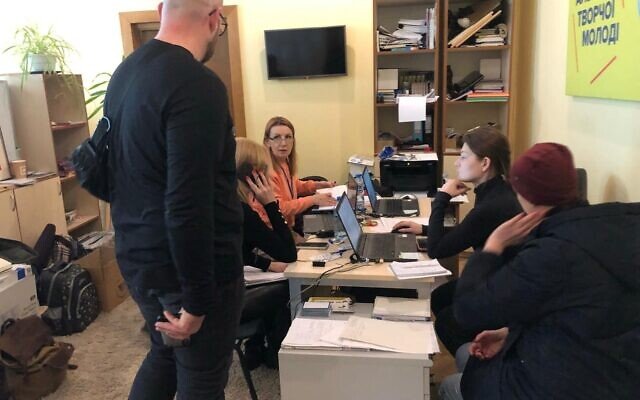Ukraine’s leading art museum transforms into busy volunteer hub

Written by Lazar Barman, originally published by The Times of Israel, 5 March, 2022.
LVIV, Ukraine –The Lviv National Art Gallery is Ukraine’s leading art museum, and for good reason. Founded in 1902, when this western Ukrainian city was part of the Austro-Hungarian Empire, its permanent collection now boasts over 60,000 pieces spanning seven centuries.
The museum’s most famous work is “The Moneylender” by 17th-century French Baroque artist Georges de la Tour.
With Ukraine now under attack by Russia, the gallery is shuttered, its masterpieces stashed away at the museum’s branch in the Potocki Palace or behind high piles of sandbags.
The museum’s offices, however, have never been busier.
Outside, a line of young Ukrainians snakes out to Kopernyka Street, eager to volunteer in support of their country’s fight against Russia.
The bottom floor is filled with women packing cardboard boxes with medical supplies.
The operation is overseen by a Leopolitan named Mark Fetsych, head of oncology at a local hospital before the invasion.
Now, he spends twelve hours a day at the museum and very little time at the hospital.

“In my everyday practice, I can help only a few people per day,” Fetsych explained. “But right now, coordinating this medical unit, we can help thousands of people.”
Goods come in from Europe and the US, he said. Ukraine has a logistical center in Poland and sends goods from there to Lviv.
The museum hosts one of five volunteer sorting and shipping centers in Lviv.
At the entrance to what is now the medical floor, boxes coming in from Poland are opened and sorted into boxes. Other women holding lists fill requests and send them out to the opposite end of the medical area.
“We send everything from basics like pills, special medical equipment, military medicine, everything really,” said the surgeon.
Ninety percent of the supplies are for civilians, he said, but the country still has a major need for specialized military medical supplies, especially personal medical kits.
“Now we ask everyone around the world, if you can, give us at least something,” Fetsych pleaded.
The museum volunteer center is open 24 hours a day, seven days a week, but Fetsych said he is trying to pace himself. “I’m a surgeon, I know what it means to burn out like a doctor, so I know that very important is sleeping time, so I try around 10-11 p.m. to leave and go to sleep.”

There are hundreds of Ukrainians working away in the museum offices, all of them volunteers who heard about the center by word of mouth.
They work quickly, quietly, and seriously. Though at first, the scene seems chaotic, there is a frenetic order to the young men and women preparing food, laying out toys, and carrying bags to the trucks waiting outside.
On the third floor, Yuri Viznyak, the head of the art gallery, stands in his office. Several volunteers work the phones below a plasma TV showing the work being done in the various museum offices.
“We have been working for seven days already,” said Viznyak. “We were the first to receive the aid from our citizens. Three days ago we started to receive from Poland from abroad.”
As more supplies have come in, Viznyak has adapted his operation.
“Initially we gave supplies directly to refugees,” he explained. They now distribute to local organizations and governments.
On Wednesday alone, 55 tons of humanitarian aid went out to the eastern cities of Kharkiv and Sumy, as well as to Odesa on the Black Sea.

Outside, a blue truck was being loaded with supplies for the capital, Kyiv, a key Russian target.
Viznyak said he would continue the logistical operation as long as needed. In any event, he doesn’t have to worry about thousands of visitors coming to see European masterpieces every day.
“All pictures and art is hidden,” he explained, before shaking this reporter’s hand and promptly returning to work.